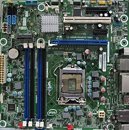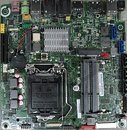Monday, February 20th 2012

Intel 7-Series Desktop Board Executive Motherboards Pictured
Two models from Intel's Desktop Board Executive series of motherboards for office PCs got pictured and detailed by VR-Zone. These socket LGA1155 motherboards are mostly based on Intel 7-series Q77 and B75 chipsets, that provide some manageability, and data security features over the feature-set of H77. Intel has three Executive series models planned, the DQ77MK, the DQ77KB, and DB75EN. Of these, the DQ77MK and DB75EN are built in the micro-ATX form-factor, while the DQ77KB is mini-ITX.
The two micro-ATX parts use a similar PCB layout, with some features differing between the two. The DQ77MK is pictured below, it has all the features a small-business PC will ever need. Expansion slots include one each of PCI-Express x16, PCI-Express x4 (open-ended), PCI-Express x1, and legacy PCI. Storage connectivity includes six SATA (one of which is mSATA, for SSD caching). The PCH gives out four USB 3.0 ports, which are wired two each on the rear-panel and via a header to the front-panel. It uses a simple 5-phase VRM that should be enough to run LGA1155 processors. The socket is wired to four DDR3 DIMM slots supporting dual-channel memory. It has a variety of external connectivity.Moving on, we see the DQ77KB, designed for ultra-compact business PCs. It retains the feature-rich Q77 chipset. It creates room on the board by replacing UDIMM slots with SO-DIMM, and makes productive use of it. Expansion slots (yes, plural) include one open-ended PCIe x4, and one mini-PCIe x1 designed for half-height PCBs such as WiFi cards. Storage connectivity includes two SATA 6 Gb/s, three SATA 3 Gb/s, and one mSATA 3 Gb/s for SSD caching. Display outputs surprisingly exclude conventional DVI and D-Sub, but replace them with LVDS, HDMI 1.4, and DisplayPort. The board replaces 24-pin + 4-pin ATX power input with 2-pin external DC input.
Source:
VR-Zone
The two micro-ATX parts use a similar PCB layout, with some features differing between the two. The DQ77MK is pictured below, it has all the features a small-business PC will ever need. Expansion slots include one each of PCI-Express x16, PCI-Express x4 (open-ended), PCI-Express x1, and legacy PCI. Storage connectivity includes six SATA (one of which is mSATA, for SSD caching). The PCH gives out four USB 3.0 ports, which are wired two each on the rear-panel and via a header to the front-panel. It uses a simple 5-phase VRM that should be enough to run LGA1155 processors. The socket is wired to four DDR3 DIMM slots supporting dual-channel memory. It has a variety of external connectivity.Moving on, we see the DQ77KB, designed for ultra-compact business PCs. It retains the feature-rich Q77 chipset. It creates room on the board by replacing UDIMM slots with SO-DIMM, and makes productive use of it. Expansion slots (yes, plural) include one open-ended PCIe x4, and one mini-PCIe x1 designed for half-height PCBs such as WiFi cards. Storage connectivity includes two SATA 6 Gb/s, three SATA 3 Gb/s, and one mSATA 3 Gb/s for SSD caching. Display outputs surprisingly exclude conventional DVI and D-Sub, but replace them with LVDS, HDMI 1.4, and DisplayPort. The board replaces 24-pin + 4-pin ATX power input with 2-pin external DC input.


4 Comments on Intel 7-Series Desktop Board Executive Motherboards Pictured